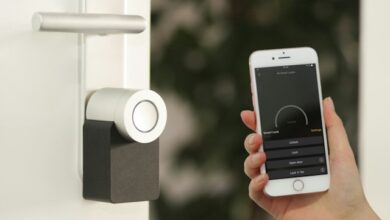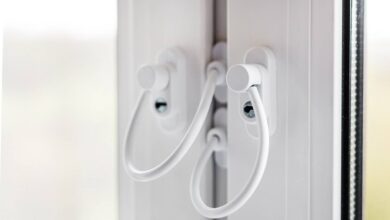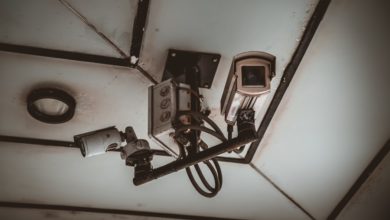Choosing The Right Wireless Security System For Your Home
Choosing the right wireless security system for your home is a crucial decision that can significantly impact your safety and peace of mind. This guide provides comprehensive insights into wireless security systems, helping you understand their components, operations, and the factors to consider when selecting the right system for your home.
We’ll also delve into the importance of system backup and recovery, ensuring you’re well-equipped to make an informed decision. Whether you’re a new homeowner or looking to upgrade your security system, this guide caters to your needs.
Understanding Wireless Security Systems
Wireless security systems represent a cutting-edge solution to safeguarding your home. Unlike traditional wired systems, these advanced systems rely on wireless signals for internal communication and interaction with the monitoring center.
The benefits of these systems are manifold, including convenience, adaptability, and robust protection against break-ins and other potential threats. By gaining a solid grasp of their key components and how they function, you can effectively identify your home’s unique security requirements and select the system that best meets those needs.
Key Components of a Wireless Security System
A wireless security system is a complex network of several critical components working in unison to secure your home:
-
Control Panel: As the heart of your security system, the control panel communicates with all other devices. It is responsible for arming and disarming the security modes, liaising with the alarm monitoring company, and issuing alerts when a security breach occurs.
-
Security Cameras: These devices monitor the interior and exterior of your home, often providing real-time footage to your smartphone. They may boast advanced features such as motion detection, night vision, and pan-and-tilt capabilities for comprehensive coverage.
-
Door and Window Sensors: These two-part devices activate the alarm system when separated. They are commonly installed on doors and windows.
-
Motion Sensors: These sensors set off an alarm upon detecting movement within their coverage area. They are particularly effective in large and centrally located areas of the home.
-
Glass Break Detectors: These specialized acoustic sensors are triggered by shattering glass, making them a valuable addition to rooms with large windows.
-
Alarm: When a security breach is detected, the system activates an audible or visual alarm to alert occupants and potentially deter intruders.
-
Remote Access: Many contemporary wireless systems offer remote access through mobile apps. This feature allows you to arm and disarm the system, receive alerts, view live feeds from your security cameras, and even control other home automation features from your smartphone.
The primary objective of these components is to deter potential intruders, detect any breaches, and alert the necessary parties. Each component is crucial in creating a comprehensive security shield around your home.
Operational Basics of Wireless Security Systems
Wireless security systems offer comprehensive protection for your home through a network of wire-free devices. These systems operate on batteries and utilize radio frequency for communication, eliminating the need for cumbersome wiring. Let’s delve into the fundamental operations of these systems:
-
System Activation and Deactivation: The control panel or a key fob allows you to arm or disarm your wireless security system. Modern systems also offer smartphone access for remote control. When the system is armed, it activates the security protocols; disarming it deactivates them.
-
Incident Detection: Sensors strategically placed around your home keep a vigilant eye for any unusual activities, such as doors or windows opening unexpectedly, movement within the house, or the sound of breaking glass. These sensors relay any detected anomalies to the control panel.
-
Alert Generation and Alarm Activation: Upon receiving a sensor’s breach signal, the control panel triggers the alarm and sends an alert to you and the monitoring center.
-
Professional Monitoring: For systems with professional monitoring, the monitoring center gets notified when an alarm is triggered. The center then reaches out to the homeowner. Law enforcement is contacted if the homeowner is unreachable or confirms a security incident.
-
Power Backup: In a power outage, the system’s battery backup ensures uninterrupted security.
-
Remote Control: Most contemporary systems offer homeowners the ability to control, monitor, and receive alerts from their system via a smartphone app.
The effectiveness of a wireless security system lies in its interconnected network of devices working in unison to respond to any potential security threats promptly. This swift detection and alert capability makes wireless security systems a trusted choice for home security.
Evaluating Home Security Needs
Before you select a wireless security system for your home, it’s imperative to assess your unique security requirements. Different homes and lifestyles necessitate varying security solutions.
Evaluating your home security needs involves two primary steps: pinpointing the vulnerabilities in your home security and acknowledging the significance of your valuables in your security planning. This self-assessment will guide you in choosing the most suitable security system and help you maximize its potential.
Spotting Home Security Weak Spots
Every dwelling has its unique set of security vulnerabilities that could potentially be exploited by intruders. Recognizing these areas of susceptibility is the first step in bolstering your home’s defenses. Here are some elements to scrutinize:
-
Entry and Exit Points: Doors and windows are often the preferred access points for intruders. Examine the state of your doors, windows, and their locking mechanisms. Ensure they provide a secure seal when closed and locked.
-
Concealment Opportunities: If your home’s entrance is hidden by foliage or your home’s interior is easily visible from the street, it could provide an ideal cover for burglars. Consider how visible your home is from different angles and distances.
-
Outdoor Illumination: Dark corners around your property can offer perfect hiding spots for potential intruders. Assess the lighting around your home, particularly near entry points.
-
Isolated Areas: Areas of your home that are secluded, like a detached garage or a basement, can be potential targets for burglars.
-
Home Occupancy: A home often vacant could be an enticing target for burglars.
Once you’ve pinpointed these risk factors, you’ll better understand where you might need to bolster your security. Combine this knowledge with the operational insights of wireless security systems to devise a robust home security strategy.
Choosing the Right Wireless Security System
Embarking on the journey to select an optimal wireless security system for your home is a task that demands meticulous attention. Having already evaluated your home’s security needs and the protection requirements of your valuable possessions, you’re now ready to delve into the specifics of different security systems. This section will navigate you through these crucial steps, helping you decide on a wireless security system that aligns with your unique needs.
Assessing System Features
Wireless security systems have many features designed to cater to distinct security requirements. To choose a system that fits your home like a glove, it’s vital to match these features with your specific security needs:
-
Sensors: As the backbone of any security system, sensors come in various forms. Depending on your home’s vulnerabilities, you might need door/window, motion, or glass break sensors.
-
Surveillance Cameras: These are your eyes when you’re not around. You might need indoor, outdoor, or doorbell cameras based on your requirements. Remember to consider the recording quality, field of view, and night vision capabilities.
-
Control Panel: This is the command center of your security system. Look for intuitive interfaces with features like system arming/disarming, emergency buttons, and smart home device connectivity.
-
Mobile App: Many wireless security systems have a mobile app for remote monitoring and control. Evaluate the app’s functionality and user-friendliness.
-
Home Automation: If you’re a fan of smart home devices or plan to introduce them, consider a system that supports home automation.
-
Monitoring Service: Some brands provide professional monitoring services for extra protection. Opt for this based on your security needs and budget.
-
Alarm: A loud, clear alarm can alert you to threats and deter intruders.
Remember, the objective isn’t to find a system with the most features but one that offers features that perfectly align with your unique home security needs.
Comparing Brands
Once you’ve identified the essential features of your wireless security system, it’s time to delve into the world of brands. Several reputable companies offer these features, and weighing them against each other is crucial. Here’s what to keep in mind:
-
Reliability: Look into the brand’s track record for consistent performance and longevity of their security systems. Online customer testimonials and ratings can provide valuable insights.
-
Price: Evaluate the upfront cost, recurring monthly charges, and the price of additional features. While budget is important, remember that the least expensive system may need to provide better security. Strive for a balance between cost, value, and quality.
-
Customer Support: Investigate the quality of the brand’s customer service. A company with robust customer support is likely to stand behind its products.
-
Technology and Innovation: Brands continually investing in technological advancements will likely keep you equipped with the latest home security technology.
-
Warranty: Look for warranties that cover the system. A warranty indicates a company’s confidence in its product’s quality and durability.
-
Installation: Some brands offer professional installation services. This could be a deciding factor if you need clarification on setting up the system.
While brand comparison may require some time and effort, it’s crucial to ensure you select a security system that best fits your home and offers you peace of mind.
Installation Considerations
The next step is installation once you’ve chosen your ideal wireless security system. Here are some key factors to consider:
-
DIY vs Professional Installation: Depending on the system’s complexity, you might be able to set it up yourself or need professional assistance. Some companies offer professional installation services for an additional fee.
-
Sensor Placement: Your wireless security system’s effectiveness hinges on the sensors’ placement. Install them at strategic points such as main entrances, windows, and areas where valuables are kept, as identified in your security planning.
-
System Compatibility: If you plan to integrate the system with existing smart home devices, ensure they are compatible. Also, verify that the system is compatible with your home’s network conditions.
-
System Testing: Conduct a comprehensive system test after installation to ensure all components are functioning correctly. This includes sensors, alarms, cameras, and remote access via a mobile app if included in your system.
-
User Training: Everyone in the household should know the security system’s operation. Ensure all members are trained on using the control panel mobile app and know what steps to take if an alarm is triggered.
Remember, the correct installation is vital to the security system’s functionality. Even the best system can leave your home vulnerable if not installed correctly.
System Backup and Recovery for Wireless Security
Ensuring uninterrupted functionality of your wireless security system, even during outages or breaches, requires a robust backup and quick recovery strategy.
Power Backup Essentials
A steadfast power backup maintains system operations during unforeseen interruptions or deliberate sabotage.
-
Battery Backup: Standard feature in most systems, providing several hours of power.
-
Portable Generators: Vital for extended outages, with models capable of days-long power.
-
Solar Power: Sustainable backup, especially useful during daylight hours.
-
Uninterruptible Power Supply (UPS): Immediate emergency power provision.
Your backup choice should reflect local power reliability, geographical and climatic factors, and other power loss triggers. A dependable backup ensures 24/7 security.
Recovery After a Security Breach A breach, while unsettling, can be a vital learning opportunity. Swiftly restoring and reinforcing your system is paramount.
-
Assess the Damage: Identify compromised or damaged components post-security breach.
-
Professional Restoration: Seek expert assistance to repair or replace affected parts.
-
System Testing: Ensure post-recovery functionality matches the system’s original standards.
-
Identify Weaknesses: Analyze breach causes and enhance system features accordingly.
-
Augment Security Measures: Introduce additional deterrents, from security lighting to visible CCTV signs.
Always report breaches to law enforcement and engage with insurance providers for potential claims. Use such incidents as a springboard to bolster home security and deter future breaches.
Conclusion
Selecting your home’s perfect wireless security system is pivotal for robust protection. By thoroughly evaluating features and brands, you ensure a system that meets your needs, providing peace of mind and unwavering security.
Read about how locksmiths can make keys out of locks from our resources at Security Forward today.




